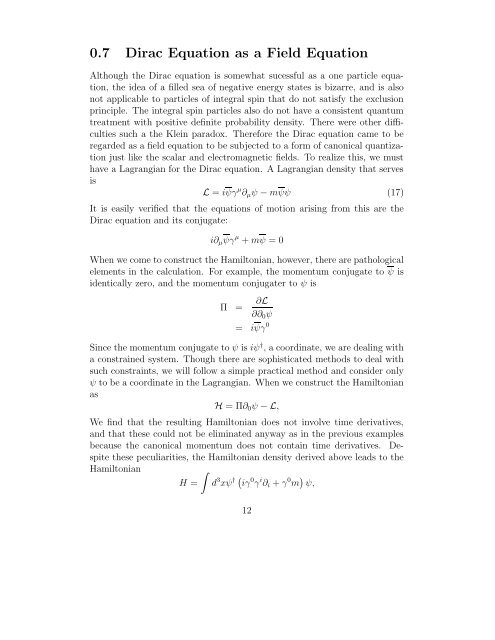0.1 Klein-Gordon Equation 0.2 Dirac Equation
0.1 Klein-Gordon Equation 0.2 Dirac Equation
0.1 Klein-Gordon Equation 0.2 Dirac Equation
You also want an ePaper? Increase the reach of your titles
YUMPU automatically turns print PDFs into web optimized ePapers that Google loves.
0.7 <strong>Dirac</strong> <strong>Equation</strong> as a Field <strong>Equation</strong><br />
Although the <strong>Dirac</strong> equation is somewhat sucessful as a one particle equation,<br />
the idea of a filled sea of negative energy states is bizarre, and is also<br />
not applicable to particles of integral spin that do not satisfy the exclusion<br />
principle. The integral spin particles also do not have a consistent quantum<br />
treatment with positive definite probability density. There were other difficulties<br />
such a the <strong>Klein</strong> paradox. Therefore the <strong>Dirac</strong> equation came to be<br />
regarded as a field equation to be subjected to a form of canonical quantization<br />
just like the scalar and electromagnetic fields. To realize this, we must<br />
have a Lagrangian for the <strong>Dirac</strong> equation. A Lagrangian density that serves<br />
is<br />
L = iψγ µ ∂ µ ψ − mψψ (17)<br />
It is easily verified that the equations of motion arising from this are the<br />
<strong>Dirac</strong> equation and its conjugate:<br />
i∂ µ ψγ µ + mψ = 0<br />
When we come to construct the Hamiltonian, however, there are pathological<br />
elements in the calculation. For example, the momentum conjugate to ψ is<br />
identically zero, and the momentum conjugater to ψ is<br />
Π = ∂L<br />
∂∂ 0 ψ<br />
= iψγ 0<br />
Since the momentum conjugate to ψ is iψ † , a coordinate, we are dealing with<br />
a constrained system. Though there are sophisticated methods to deal with<br />
such constraints, we will follow a simple practical method and consider only<br />
ψ to be a coordinate in the Lagrangian. When we construct the Hamiltonian<br />
as<br />
H = Π∂ 0 ψ − L,<br />
We find that the resulting Hamiltonian does not involve time derivatives,<br />
and that these could not be eliminated anyway as in the previous examples<br />
because the canonical momentum does not contain time derivatives. Despite<br />
these peculiarities, the Hamiltonian density derived above leads to the<br />
Hamiltonian<br />
∫<br />
H = d 3 xψ ( † iγ 0 γ i ∂ i + γ 0 m ) ψ,<br />
12
















